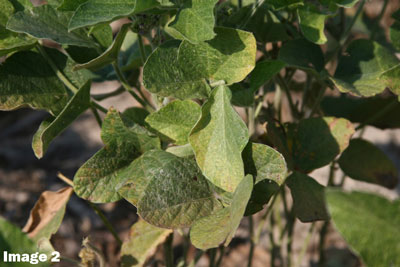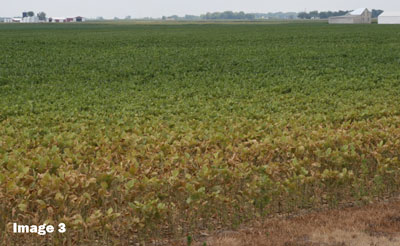- Spider mites are very small green-yellow arachnids with piercing-sucking mouthparts.
- Infested plants lose photosynthetic leaf area and are more prone to water stress.
- Spider mite populations grow more quickly at higher temperatures.
- Drought conditions can cause spider mite outbreaks in both corn and soybeans.
- Chemical controls include chlorpyrifos, dimethoate, and bifenthrin.
Identification and Biology
Two-spotted spider mites (Tetranychus urticae) are very small arachnids (1/60th inch). They range in color from green to yellow-orange and are characterized by two dark spots on the side of the body, which are actually visible digestive organs in the abdomen (Image 1). Spider mites have a simple 4-stage life cycle of egg, larvae, nymph, and adult. The life cycle is typically about 19 days, but generation times can be much shorter under hot temperatures, when populations may explode by up to a 70-fold increase in as little as 6-10 days.
Plant Injury
Spider mites pierce the cell wall and suck out the contents of the cell. The characteristic injury is a yellow 'stippling' effect, mostly on the underside of the leaf (Image 2). The affected leaves lose photosynthetic surface area and can no longer prevent water loss from the cells. As injury intensifies, leaves turn yellow or coppery and then fall off the plant. The cumulative injury effect is reduced pod set, fewer seeds, and smaller seed size.
Spider mites migrate into crops as nearby primary food sources become depleted. Outbreaks can be most severe during drought, which accelerates dry down of surrounding vegetation, makes the soybeans a more nutritious food option, and slows down the fungal diseases that normally keep the mite populations in check.
Scouting and Thresholds
The pattern of injury in a field is typically a V-shaped or semi-circle pattern of yellowing along the edge of the field, especially near a grass border (Image 3). Injury typically starts on the lower portion of the canopy and eventually moves upward. Spider mites also produce webbing on the underside of the leaves, a feature which gave rise to their name. Shake infested plants over a white sheet of paper and use a hand lens to observe the mites. Observe several locations and make note of the extent of injury. Populations can be explosive, so fields should be scouted every 4-5 days.
Growth stages R4 (full pod) and R5 (beginning seed) are the most critical for spider mite yield impact. A 10-15% reduction in effective leaf area will justify chemical controls, but this level of injury can be difficult to estimate. Our objective is to protect the middle and upper canopy from injury. Spray threshold is when heavy stippling is observed on lower leaves and progresses into the middle canopy, mites are present in the middle and upper canopy, and some lower leaves have yellowed and are starting to drop off the plant.
Management
Insecticides recommended for control of spider mites are those containing chlorpyrifos, dimethoate, and bifenthrin. With the exception of bifenthrin, most modern pyrethroids are ineffective against spider mites and may actually 'flare' mite populations, as predatory insects are inadvertently eliminated.
Both chlorpyrifos and dimethoate are organophosphate contact insecticides, which require excellent coverage on the underside of the leaf for effective control. Use high carrier volumes of 20 GPA for ground applications and 5 GPA for aerial applications. Neither chlorpyrifos nor dimethoate will provide control on unhatched eggs. Bifenthrin has residual activity for a few days on hatching eggs. Residual duration of most insecticides is reduced by high temperatures.
Control level should be monitored in 5 days to determine if additional applications are required. If a respray is needed, try to rotate mode of action to avoid development of field resistance to the insecticide. Always read and follow label directions.
Contact your FS Crop Specialist fro your agronomic information.
References:
Managing Two-Spotted Spider Mites on Soybeans (University of Minnesota)
Two-Spotted Spider Mite (Purdue University)


Image 1: Spider Mites on teh underside of a soybean leaf (GROWMARK, Inc.)
Image 2: Characteristic spider mite stippling injury on soybean leaves (GROWMARK, Inc.)
Image 3:Spider Mite injury pattern on edge of soybean field (GROWMARK Inc.)